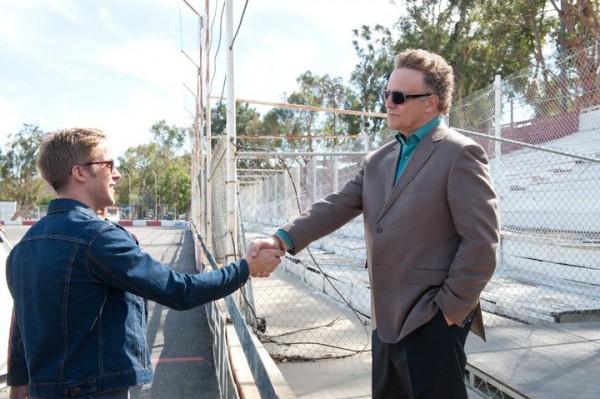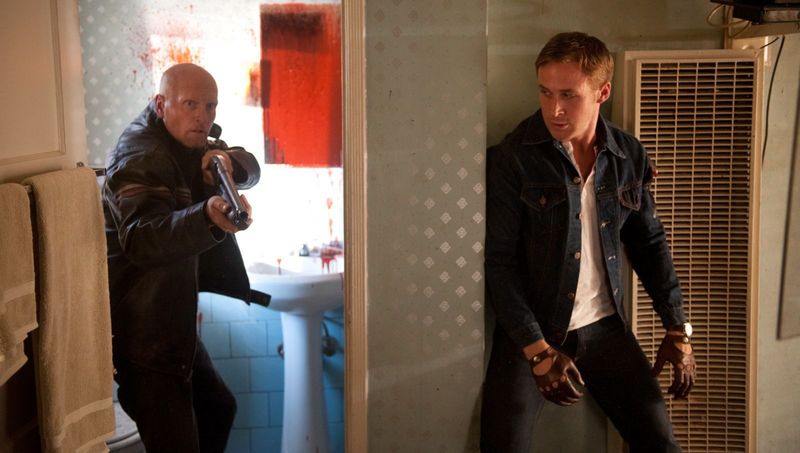REVIEW: "Drive"
Nicolas Winding Refn’s Drive is one of those rare movies that breaks out of the restraints of the screen and comes into the theatre with you. The film then grabs you by the throat and holds you to your seat.
It does this not through its use of violence (which is plentiful is some scenes), but by its taut pacing and incredible performances. Every element feels precisely measured to deliver a concussive effect from even the quietest scenes. Rather than ponder what the characters are doing, we spend more time getting to know who they are, an approach that feels fresh and involving.
Ryan Gosling plays the otherwise unnamed Driver, who works “only part-time” as a Hollywood stunt driver by day, and as an efficient getaway driver by night. Driver doesn’t speak much, but when he does, his words are well-chosen and succinct. We don’t learn how Driver came to be this way, but we don’t need to. For Driver, actions like helping his pretty neighbour (Carey Mulligan) with her groceries or looking after her young son are enough.
Through his developing friendship with his neighbour Irene, Driver learns that her husband Standard (Oscar Issac) will soon be released from prison. This means that Standard’s world and Driver’s night job are one and the same. When Standard learns that he owes protection money to a gangster, Driver is compelled to use his skills to help, as it will protect the family Driver has befriended.
Suddenly, Driver is no longer dispassionately connected to crime, and this marks an important change in the story. Driver begins to fight an escalating war, drawn out by the spiralling nature of organized crime. Despite his past involvement with heists, Driver always remained on the outside, providing a service. Now that he has formed personal connections with Irene, Standard and their son Benicio, those relationships are pulled into the criminal underworld, a frightening and serious consequence for a professional like Driver.
If it seems like this review is written in an overly dramatic style, it’s because I’m trying to convey just how Drive made me feel. The movie is tense to the point of breaking. Exchanges of dialogue (they aren’t really conversations) between Driver and Irene sometimes contain only a few words. These sequences are slow, but it’s a very rewarding slowness. When the characters do speak, their words are charged with the audience’s anticipation of an end to the silence, making the words carry much more weight.
When the action scenes occur, they have a similar effect to the pacing of the dialogue: the scenes are brief, intense and violent. Single gunshots will make you jump, hand-to-hand fights are visceral and believable. Sometimes the onscreen violence approaches the excessive, which might turn some away from this film. Nevertheless, I felt that the blood was a necessary addition considering the themes of the film: illicit money, organized crime and high stakes.
Gosling and Mulligan are the standout performers here, but that’s taking into account the riveting supportive work by Bryan Cranston, Christina Hendricks and Ron Perlman. Gosling, as he does with most of his roles, inhabits Driver. We don’t know what fuels his violent side, but it is both frightening and oddly admirable. Mulligan plays the victimized young mother/wife, but she doesn’t take the character in the expected direction of sudden love interest for the protagonist, which I appreciated.
The cinematography by Newton Thomas Sigel accentuates the flatness of Los Angeles, highlighting it as a driver’s paradise. The city is like a huge maze, where mice and rats zoom about questing for a reward. The lighting is yellowed, implying a tired, faded worldview. The film doesn’t give us a history lesson about crime in the city, but we know almost instinctively from the visuals in Drive that Los Angeles has a sordid past to rival its glitzy image.
These choices feed into the lack of information about Driver’s past. There’s a feeling that something happened to him that we’d prefer not to know about. What’s more important is how Driver finds himself in this town that can offer him plenty of opportunities, both legal and not. Drive is a window into several days in the life of this character, as Driver struggles to stay alive in the middle of a criminal underworld on whose edges he has dwelt for years.
Nicolas Winding Refn deserves considerable credit for crafting such a consistent, potent movie. There is an overwhelming sense of a single vision guiding Drive: not once does it feel divided or confused. Refn knows his characters, how they would behave, and keeps everything under tight control until those certain, violent moments in the story when nothing can be controlled.
Perhaps it is the violence that keeps Drive from reaching a “perfect score”. I hate to deal in absolutes in my reviews, but such is the convention of the reviewing style. The violence in the movie is intense, and as I mentioned, thematically justified, but seeing it can still take you out of the experience. There are enough audible drips of blood and gurgling deaths to make even the strong-stomached wince a bit. Suffice it to say, there were a few sounds of discomfort at my screening when a head exploded or a body part was impaled.
I don’t know if the movie could have been improved by a more restrained use of violence, but as it is, for the taut direction, impressive performances and brilliant pacing, Drive gets three and half stars out of four.
Have you seen Drive? What did you think about the components I pointed out? Did I miss any major material in the film? Were you at all put off by the violence, or maybe even bored by the slower sections? Post your thoughts in the comments section below!
Read up on some of my other reviews:
Reviews of Classic Movies:
The Graduate (1967) | Rope (1948) | 2001: A Space Odyssey (1968)
Recent 2011 Releases:




